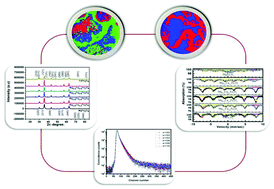Defect-focused analysis of calcium-substitution-induced structural transformation of magnesium ferrite nanocrystals†
Abstract
Calcium-substituted magnesium ferrite (Mg1−xCaxFe2O4, x = 0.0, 0.2, …, and 1.0) nanocrystalline samples, prepared through a sol–gel method, were characterized by X-ray diffraction and transmission electron microscopy, and the physico-chemical properties were studied using optical absorption, Fourier transform infrared (FTIR) and Mössbauer spectroscopic measurements. The sizes of the nanocrystallites ranged from 8 nm at x = 0.0 to 28 nm at x = 1.0. The optical band gap decreased with substitution, indicating weak quantum confinement effects diminishing for larger nanocrystallites. FTIR studies indicated disappearing stretching vibrations of Mg–O bonds at higher Ca2+ concentrations and Ca–O bonds appearing in their places. AFM and confocal Raman images showed a high degree of disorder in the cationic distribution and the observation was supported by energy dispersive analysis of X-rays that indicated cation deficiencies from the expected concentrations at the tetrahedral (A-) and octahedral (B-) sites. Positron annihilation studies were carried out to characterize the defects and the results suggested that the Ca2+ ions take Mg1−xCaxFe2O4 through an orthorhombic route to structural stability. The transformation resulted in the reduction of strain with substitution despite Ca2+ ions having larger radii than those of Mg2+ ions. Positron lifetime results confirmed the presence of vacancy-type defects arising from the failed occupancy of the Mg2+ sites by Ca2+ ions during the transformation. Most vacancies were at the B-sites, where the majority of the Mg2+ ions initially resided in the (Mg0.1Fe0.9)[Mg0.9Fe1.1]O4 structure. Coincidence Doppler broadening spectroscopy of the annihilation gamma rays indicated an increasing proximity of positrons to oxygen electrons owing to the increasing vacancy concentration arising from the deficiency of cations at the B-sites. Mössbauer spectroscopic studies confirmed the ferromagnetic nature of the samples and the increased isomer shift implied the charge state of the Fe ions as 3+, outlining the effective screening of the 3d electrons.



 Please wait while we load your content...
Please wait while we load your content...